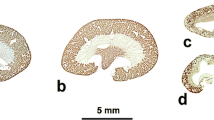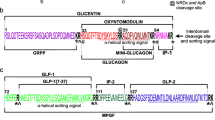Summary
A monoclonal antibody against an antigen (PCD2) derived from the rabbit renal papilla recognized principal and intercalated cells of the collecting duct system in the adult rabbit kidney. Intercalated cells were heterogeneous in the connecting tubule and the cortical collecting duct, where immunoreactive and unreactive cells were shown to coexist. In the outer medullary collecting duct, all intercalated cells exhibited PCD2-immunoreactivity. Connecting tubule cells proper were not recognized by the antibody, whereas all principal cells of the collecting duct revealed specific immunoreactivity. The immunocytochemical heterogeneity of the intercalated cells is discussed in terms of a functional heterogeneity. Cytologically, the immunogold labeling of principal and intercalated cells was shown to occur along the plasmalemma, in the intracellular membrane structures and along the Golgi transport route. This pattern suggests that the antigenic determinant, which is ubiquitous in both principal and reactive intercalated cells, belongs to a membrane protein.
Similar content being viewed by others
References
Bachmann S, Koeppen-Hagemann I, Kriz W (1985) Ultrastructural localization of Tamm Horsfall Glycoprotein (THP) in rat kidney as revealed by protein A-gold immunocytochemistry. Histochemistry 83:531–538
Bendayan M, Zollinger M (1983) Ultrastructural localization of antigenic sites on osmium fixed tissues applying the protein A-gold technique. J Histochem Cytochem 31:101–109
Brown WJ, Farquhar MG (1984) Mannose-6-phosphate receptor recycling during recovery from chloroquine or NH4Cl treatment (abstr). J Cell Biol 99:78 a
Brown D, Roth J, Orci L (1985) Lectin-gold cytochemistry reveals intercalated cell heterogeneity along rat kidney collecting ducts. Am J Physiol 248:C348–356
Brunisholz M, Geniteau-Legendre M, Ronco PM, Moullier P, Pontillon F, Richet G, Verroust PJ (1986) Characterization of monoclonal antibodies specific for human Tamm-Horsfall protein. Kidney Int 29:971–976
Cordon-Cardo C, Bander NH, Fradet Y, Finstadt CL, Whitmore WF, Lloyd KO, Oettgen HF, Melamed MR, Old LJ (1984) Immunoanatomic dissection of the human urinary tract by monoclonal antibodies. J Histochem Cytochem 32:1035–1040
Dorup J (1985a) Ultrastructure of distal nephron cells in rat renal cortex. J Ultrastruct Res 92:101–118
Dorup J (1985b) Structural adaptation of intercalated cells in rat renal cortex to acute metabolic acidosis and alkalosis. J Ultrastruct Res 92:119–131
Drenckhahn D, Schlüter K, Alien DP, Bennett V (1985) Colocalization of band 3 with ankyrin and spectrin at the basal membrane of intercalated cells in the rat kidney. Science 230:1287–1289
Farquhar MG (1983) Multiple pathways of exocytosis and membrane recycling: Validation of a Golgi route. Fed Proc 42:2407–2413
Gilbert P, Minuth WW, Bachmann S (1987) Microheterogeneity of the collecting duct system in rabbit kidney as revealed by monoclonal antibodies. Cell Tissue Res (in press)
Griffith G, Pfeiffer S, Simons K, Matlin K (1985) Exit of newly synthesized membrane proteins from the trans cisterna of the Golgi complex to the plasma membrane. J Cell Biol 101:949–964
Kaissling B, Kriz W (1979) Structural analysis of the rabbit kidney. Adv Anat Embryol 56:1–123
Karnovsky MJ (1971) Use of ferrocyanide-reduced osmium tetroxide in electron microscopy (Abstract). J Cell Biol 51:146 a
Kashgarian M, Biemesderfer D, Caplan M, Forbush B (1985) Monoclonal antibody to Na, K-ATPase: Immunocytochemical localization along nephron segments. Kidney Int 28:899–913
Koeppen-Hagemann I, Bachmann S, Minuth WW, Kriz W (1984) Immunohistochemical localization of a protein fraction derived from rabbit renal papilla. Histochemistry 81:457–464
Le Hir M, Kaissling B, Koeppen BM, Wade JB (1982) Binding of peanut lectin to specific epithelial cell types in kidney. Am J Physiol 242:C117–120
Levine DZ, Jacobson HR (1986) The regulation of renal acid secretion: New observations from studies of distal nephron segments. Kidney Int 29:1099–1109
Lombard WE, Kokko JP, Jacobson HR (1983) Bicarbonate transport in cortical and outer medullary collecting tubules. Am J Physiol 244:F289–296
Madsen KM, Tisher CC (1983) Cellular response to acute respiratory acidosis in rat medullary collecting duct. Am J Physiol 245:F670–679
Madsen KM, Tisher CC (1984) Response of intercalated cells of rat outer medullary collecting duct to chronic metabolic acidosis. Lab Invest 51:268–276
Madsen KM, Tisher CC (1986) Structural-functional relationships along the distal nephron. Am J Physiol 250:F1–15
McKinney TD, Burg MD (1977) Bicarbonate transport by rabbit cortical collecting tubules. Effect of acid and alkali loads in vivo on transport in vitro. J Clin Invest 60:766–768
Minuth WW, Lauer G, Bachmann S, Kriz W (1984) Immunocytochemical localization of a renal glycoprotein (gpCDI) synthesized by cultured collecting duct cells. Histochemistry 80:171–182
Ronco P, Geniteau M, Poujeol P, Melcion C, Verroust P, Vandewalle A (1986) Characterization of monoclonal antibodies to rabbit renal cortical cells. Am J Physiol 250:C506–516
Schuster VL, Bonsib SM, Jennings ML (1986) Two types of collecting duct mitochondria-rich (intercalated) cells: lectin and band 3 cytochemistry. Am J Physiol 25:C347–355
Schwartz GJ, Barasch J, Al-Awqati Q (1985) Plasticity of functional epithelial polarity. Nature 318:368–371
Simons K, Fuller SD (1985) Cell surface polarity in epithelia. Ann Rev Cell Biol 1:243–288
Spielman WS, Sonnenberg WK, Alien ML, Arend LJ, Gerozissis K, Smith WL (1986) Immunodissection and culture of rabbit cortical collecting tubule cells. Am J Physiol 251:F348–357
Star RA, Burg MB, Knepper M (1985) Bicarbonate secretion and chloride absorption by rabbit cortical collecting ducts. Role of the chloride/bicarbonate exchange. J Clin Invest 76:1123–1130
Steinmetz PR (1986) Cellular organization of urinary acidification. Am J Physiol 251:F173–187
Stokes JB, Tisher CC, Kokko JP (1978) Structural-functional heterogeneity along the rabbit collecting tubule. Kidney Int 14:585–593
Stone DK, Seldin DW, Kokko JP, Jacobson HR (1983) Anion dependence of rabbit medullary collecting duct acidification. J Clin Invest 71:1505–1508
Author information
Authors and Affiliations
Rights and permissions
About this article
Cite this article
Bachmann, S., Gilbert, P. & Minuth, W.W. Electron-microscopic immunogold localization of a collecting-duct antigen (PCD2) in intercalated and principal cells of rabbit kidney. Cell Tissue Res. 249, 633–640 (1987). https://doi.org/10.1007/BF00217335
Accepted:
Issue Date:
DOI: https://doi.org/10.1007/BF00217335




